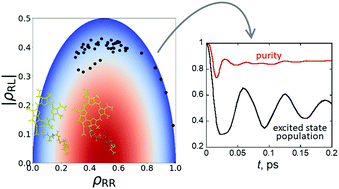Density matrix and purity evolution in dissipative two-level systems: I. Theory and path integral results for tunneling dynamics
Abstract
The time evolution of the purity (the trace of the square of the reduced density matrix) and von Neumann entropy in a symmetric two-level system coupled to a dissipative harmonic bath is investigated through analytical arguments and accurate path integral calculations on simple models and the singly excited bacteriochlorophyll dimer. A simple theoretical analysis establishes bounds and limiting behaviors. The contributions to purity from a purely incoherent term obtained from the diagonal elements of the reduced density matrix, a term associated with the difference of the two eigenstate populations, and a third term related to the square of the time derivative of a site population, are discussed in various regimes. In the case of tunneling dynamics from a localized initial condition, the complex interplay among these contributions leads to the recovery of purity under low-temperature, weakly dissipative conditions. Memory effects from the bath are found to play a critical role to the dynamics of purity. It is shown that the strictly quantum mechanical decoherence process associated with spontaneous phonon emission is responsible for the long-time recovery of purity. These analytical and numerical results show clearly that the loss of quantum coherence during the evolution toward equilibrium does not necessarily imply the decay of purity, and that the time scales relevant to these two processes may be entirely different.

- This article is part of the themed collection: 2021 PCCP HOT Articles


 Please wait while we load your content...
Please wait while we load your content...
